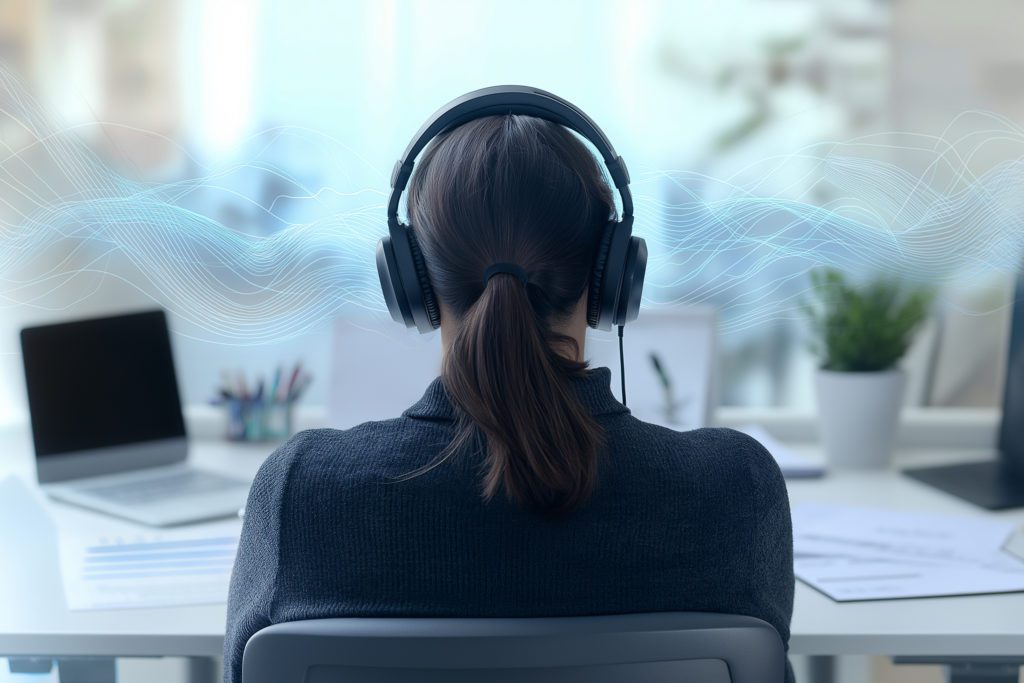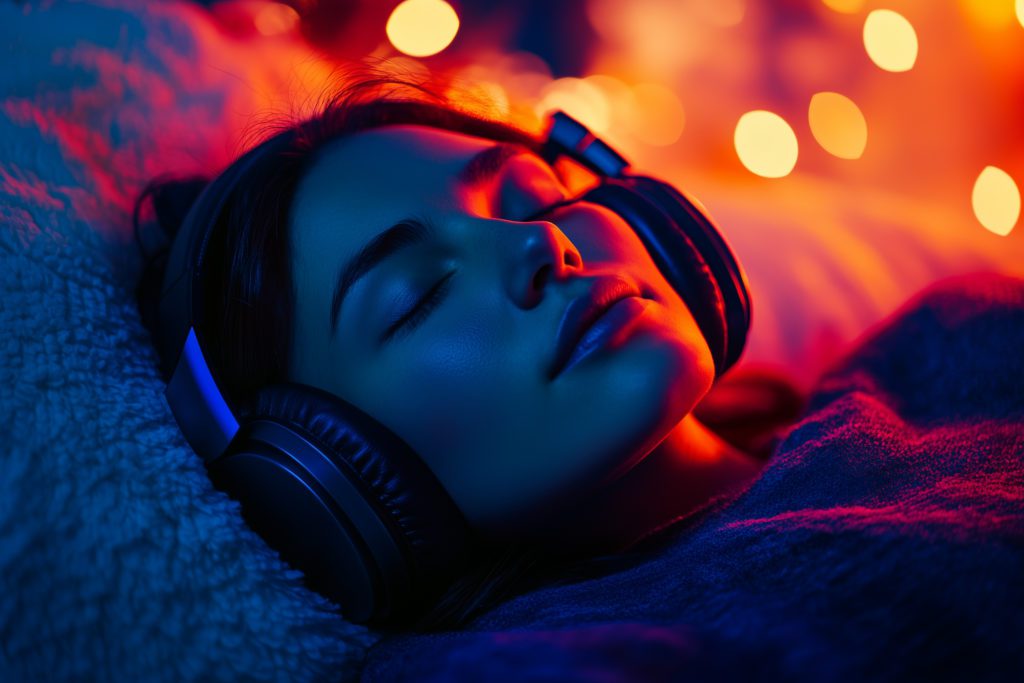
Binaural Beats and Sleep Enhancement
Let’s find out how binaural beats, an auditory illusion created by playing different frequencies in each ear, can help improve sleep quality and promote relaxation.

We all know the feeling of tossing and turning and checking the clock every few minutes, thinking, "How can I be so tired and yet so awake?" In the search for better sleep, people are turning to some interesting methods—one of which is binaural beats.
Binaural beats are a type of soundwave therapy that's making waves in the world of sleep enhancement. They're essentially an auditory illusion created when two different frequencies are played into each ear. Your brain gets a little confused and creates a third tone that only it can hear.
But why should you care? Because sleep isn't just about closing your eyes and hoping for the best. It's a vital part of our overall well-being, affecting everything from mood to memory to metabolism. And in a world where quality sleep is becoming a rare commodity, people are exploring all sorts of techniques to improve their sleep quality. That's where binaural beats come in.
What Are Binaural Beats?
Imagine you are listening to two different drummers. One drummer is playing a steady beat at 300 Hz in your left ear, while the other is playing at 310 Hz in your right ear. Your brain doesn't know which beat to follow. So, it improvises and hears a new beat—the difference between the two frequencies, in this case, a 10 Hz beat. That's the binaural beat.
But how does this relate to sleep?
Different brainwave frequencies are associated with various mental states. For instance, delta waves (1-4 Hz) are linked to deep, restorative sleep, while theta waves (4-8 Hz) are associated with light sleep and deep relaxation. The idea is that by listening to binaural beats set to these frequencies, you can encourage your brain to naturally transition into these restful states, sort of like using music to gently nudge a toddler to bed.
Binaural beats have been categorized into five types based on the frequencies used:
- Delta (1-4 Hz): Deep sleep and unconsciousness.
- Theta (4-8 Hz): Light sleep, relaxation, and creativity.
- Alpha (8-14 Hz): Relaxed focus and calmness.
- Beta (14-30 Hz): Active thinking and problem-solving.
- Gamma (30-100 Hz): Higher cognitive functions and peak awareness.
So, when we talk about "binaural beats for sleep," we're mainly interested in those lower frequencies—delta and theta.
How Binaural Beats Affect Sleep?
When you listen to binaural beats set at a specific frequency, your brain's electrical activity can begin to mirror that frequency—a phenomenon known as "frequency following response." Essentially, your brain likes to sync up its activity to match the external beats.
This process is thought to help guide the brain into a state that's conducive to better sleep, especially if the beats are tuned to frequencies associated with sleep states like delta and theta.
A study published in the Digital Health journal found that listening to delta-frequency binaural beats before bed helped participants fall asleep faster and spend more time in deep sleep stages. Another study from Applied Sciences revealed that individuals who listened to binaural beats experienced reduced levels of anxiety and stress, which are often major culprits behind sleepless nights.
But before you run off to start using these tones, it's worth noting that binaural beats aren't a one-size-fits-all solution. Not everyone responds to them the same way. Some people may find them incredibly relaxing, while others might just end up tapping their feet to the rhythm.
The effectiveness of binaural beats for sleep can depend on several factors, including individual brainwave patterns, the quality of headphones used, and even how open you are to the idea in the first place.
How to Use Binaural Beats for Better Sleep?
So, you're convinced and ready to give binaural beats a try. But where do you start? Don't worry. We've got you covered with a simple guide on how to use binaural beats for sleep.
Step One: Choose Your Frequency
The first step is selecting the right frequency. Remember, for sleep, you're looking for beats in the delta (1-4 Hz) or theta (4-8 Hz) ranges. These frequencies are associated with relaxation and restorative sleep.
You can find playlists or apps specifically designed for sleep that offer these frequencies. For example, Pillow's Sleep Aid features a range of binaural beats designed to help you relax and drift into sleep.
Step Two: Get the Right Equipment
To get the full benefit of binaural beats, you need a good pair of stereo headphones. This is because binaural beats work by sending two different frequencies to each ear, and the illusion of the third beat happens in your brain. Plus, comfortable headphones are key; you don't want to trade sleep troubles for a sore ear.
Step Three: Create a Relaxing Environment
This might seem like a no-brainer, but creating the right sleep environment is crucial. Dim the lights, put your phone on do not disturb, and make sure your room is at a comfortable temperature.
Step Four: Start Listening
Lie down, get comfortable, and press play. Start with about 15 to 30 minutes of listening time. Some people might fall asleep quickly, while others may need more time to relax fully.
The key here is consistency—try it for several nights to see how your body responds. And remember, if you start to feel anxious or uncomfortable, it's okay to stop. The goal is to relax, not to stress about relaxing.
Step Five: Experiment and Adjust
Like anything, finding the perfect binaural beats routine might take some tweaking. Don't be afraid to try different frequencies, lengths of time, or even different types of beats.
And there you have it—a simple, friendly guide to using binaural beats for better sleep. By tapping into the natural rhythms of the brain and guiding it into states conducive to rest, these auditory illusions have the potential to help you fall asleep faster, sleep more deeply, and wake up feeling more refreshed. And let's be honest—anything that can potentially make bedtime a little easier is worth a shot.
FAQ
Do binaural beats work if played through speakers instead of headphones?
No, binaural beats require stereo headphones to be effective. The illusion of the third perceived frequency relies on the separation of distinct frequencies delivered to each ear, which cannot be achieved through regular speakers.
Are there specific times of day when listening to binaural beats is most effective?
Binaural beats can be used at different times depending on the desired effect. Delta and theta beats are best for nighttime use to promote sleep, while alpha and beta beats can be helpful in the morning or afternoon to boost focus and productivity.
Are there any cultural or historical origins of binaural beats?
While binaural beats as a concept were scientifically identified in the 19th century, the idea of using rhythmic auditory stimulation to influence mental states has been present in various cultures through drumming, chanting, and other sound-based practices.
Can binaural beats influence heart rate and breathing patterns?
Yes, binaural beats, especially in lower frequency ranges, can promote relaxation by slowing heart rate and encouraging deep breathing, which can help prepare the body for sleep or reduce stress levels.
How do binaural beats compare to other sleep-inducing sounds like white noise or nature sounds?
Binaural beats work by influencing brainwave activity, while white noise and nature sounds primarily mask background noise to create a more calming environment. Some people find binaural beats more effective for deep relaxation, while others prefer traditional ambient sounds.

Written by
Dr Aqsa
As a Medical Doctor, Dr Aqsa, uses her knowledge to craft complex medical information that is understandable to the general public. For years, she has tried to improve health literacy and empower readers with valuable health knowledge through her articles, blog posts, and educational materials.
Download Pillow
Get help
Press & News
Legal
Connect
X (Twitter)
Company
Copyright © Neybox Digital Ltd.


